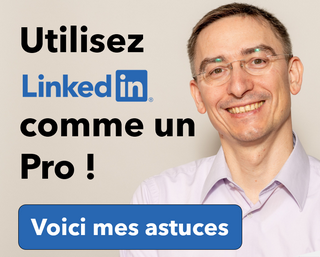A lot of people ask me “how can I get more visibility on Linkedin, Twitter, Youtube, Facebook…”
My first response is always to say it’s not the opinions that matter, it’s the lead generation…
So my strategy on Linkedin is to create a network of qualified contacts, convince them that I am an expert in the field, and then create an initial exchange (especially through an “event” like a webinar, guide, etc.) .
However, the second strategy is to create viral content that gets thousands of views and gets you featured in the news feed.
The problem is that it’s much harder…
The proof of this is that most posts only get a few likes and comments (and often from the same friends and colleagues who are trying to support you).
And why is it so difficult to have more visibility?
The #1 reason is simply that most people have forgotten that the most important thing about social media is SOCIAL. Remember that Linkedin, Facebook, Twitter, Instagram… have only one goal: to make you stay online for a long time.
However, they prefer not “expert” content but “emotional” content that will make people react and therefore stay on their site longer…
This is why you need to tailor your social media messages to generate interactions and not just “share content”.
Here are some examples of content that is a flop in terms of virality:
- A company that talks about itself with its next webinar, latest white paper, press release…
- A consultant or blogger who gives their X top-down tips for success, who shares their super awesome latest blog post…
- …
All these contents have 2 things in common:
- to be navel-gazing
- push information.
It’s a bit like a guy with a loudspeaker trying to get your attention by talking loudly.
Conversely, to start a conversation, you need to switch to conversation mode and customize your content.
This is why successful publications often use:
- Provocation by providing a very clear opinion to elicit responses.
- Good News (meetings, job changes, etc.) encourage people to like For example, when I announce X thousand sales of my book “Growth Hacking”, I get more virality than just talking about the book.
- Content You Can Only Like because it elicits an affirmative response. For example, a quote, a funny picture, a video full of emotions… in which everyone can relate. This is the content of the “endorsement”.
You tell me, that’s very nice, but I’d also like to promote my expertise… not posting cat videos or starting controversies…
And you are right!
In this case, you need to find that famous first interaction and turn a “one-way” post into a “conversation”.
Here’s an example in before/after mode:
- Before in “one way” mode: “Discover my top 10 SEO tools for small and medium businesses. I have collected 10 essential software for improving website SEO…”
- Then in “Conversation” mode: “What are the 2 essential SEO tools for you?
- I’ve created a Top 10 Tools to Improve Website SEO, but I’m afraid I’ve forgotten some essential software. Can you tell me in the comments if I forgot the 1st and 2nd essentials…”
Did you get the difference?
The one-way is sure to pique the curiosity of your fans and those who really want to know more. But the other in conversational mode will encourage them to comment, like, share… without even reading your article! And thanks to this, your post will be rated better and will have more visibility on the social network. If you want to get more visibility, you need to stop doing like everyone else and share your blog articles, videos, etc. one way.
You need to edit the message to join the conversation from the first line.
This change in mentality is especially difficult for the “older generations” because they do not have the reflex to engage in “discussion”. You have to change your state of mind and dare to go into conversation mode so that you don’t stay in the discourse.
Be aware that there are also “backdoors” to switch to conversation mode, such as:
- Offer surveys through built-in survey tools or even more cleverly by asking for a reaction with emojis to make the algorithm believe that people like your content.
- Ask for opinions on several options for product names, packaging, visuals, etc. to anticipate the product launch.
- Share something that happened to you and has already happened to your target (eg first time, difficult choice, etc.) and ask them to share their experience.
- …
Now it’s your turn, start the conversation!
The next time you post on social media, make sure that what you write really sparks a conversation.


